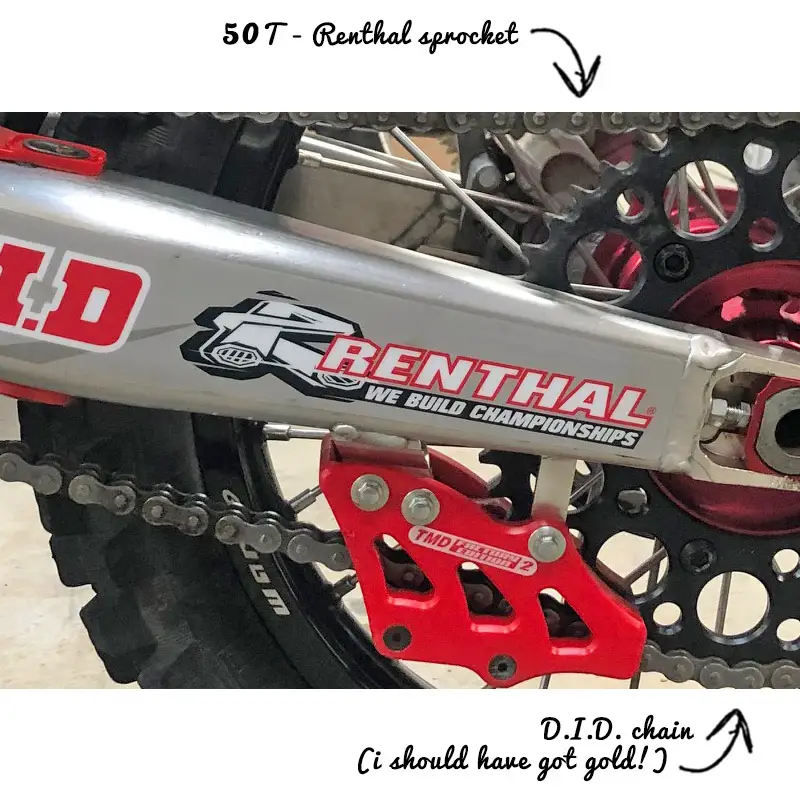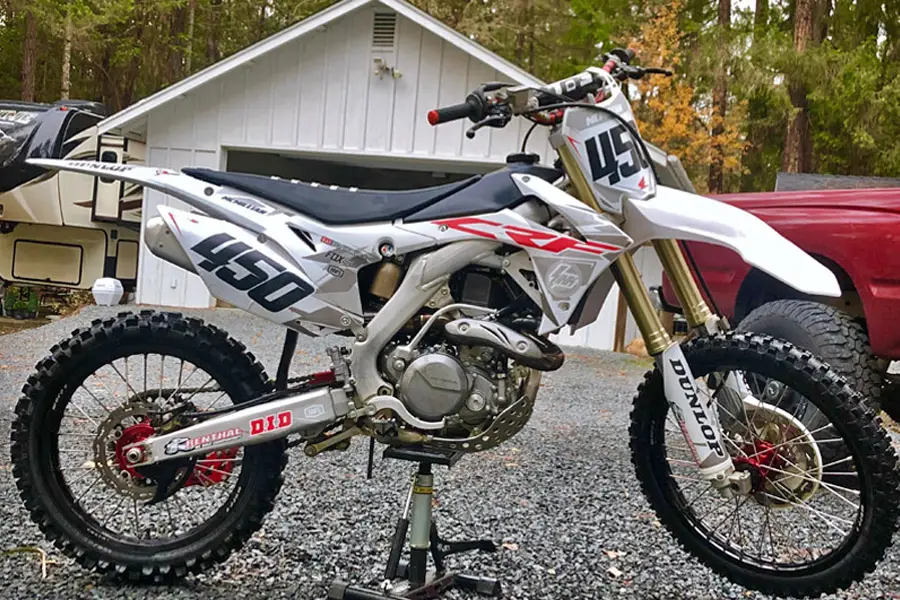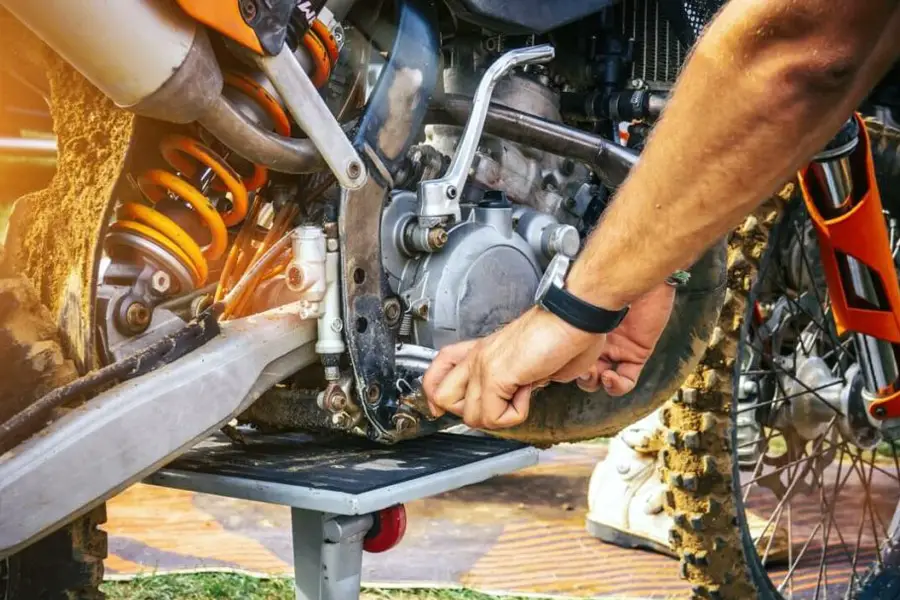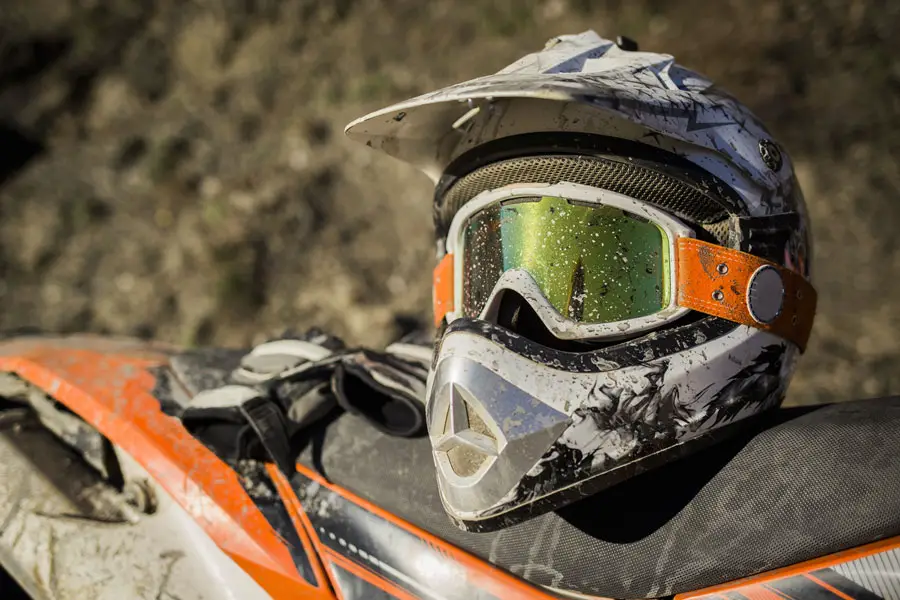How to Gear Down a Dirt Bike for Trail Riding and Woods
BraapAcademy.com earns a small commission from qualifying purchases.
This does NOT cost you extra.
Contents
The stock gearing on a motocross bike is not ideal for riding in the woods. However, there are a lot of guys that find a good deal on a motocross bike (or just think they look cooler… I’m guilty as well) so they end up with a bike that isn’t specifically designed for the type of riding they do most. And guess what. That’s okay because it’s pretty easy to gear down a dirt bike for trails.
To gear down a dirt bike for trails and woods, just replace one (or both) of the sprockets and possibly the chain. If you want to gear the bike down, increase the size of the rear sprocket or decrease the size of the front sprocket. That’s it! Well, mostly.

As with any modifications to your motorcycle, it’s wise to consult your owners manual. Also, here are some important things to take into consideration.
- Gearing ratio
- Front and rear sprocket sizing
- Chain length
What’s the Best Gear Ratio?
Finding “the best” gear ratio is debatable. And in reality, there isn’t one gear ratio that reigns supreme.
Different tracks, trails, and riding conditions all demand a slightly different gear ratio. However, for the 92.738% of us (approximately) that are not pros and just want to go out and have some fun riding, it’s certainly not worth switching out your chain and sprockets every time circumstances change.
If you mostly ride trails, gear your bike for that. If you mostly ride high-speed dessert, gear your bike for that.
Differences Between Gearing
Lower gearing:
- Decrease teeth on the front sprocket and/or increase teeth on the rear sprocket
- Better acceleration
- Less top speed
- Better for tight, technical riding
- Often better for beginners
Higher gearing
- Increase teeth on the front sprocket and/or decrease teeth on the rear sprocket
- Higher top speed
- Less bottom end power
- Better for fast, desert riding
Gear Ratio Chart for Dirt Bikes
The gear ratio is determined by how many revolutions of the front sprocket occur for every revolution of the rear sprocket.
For example, as you’ll see in the chart below, if you have 40 teeth on the rear sprocket and 10 on the front, you get a ratio of 4.00.
40÷10=4.00
| 10 Front | 11 Front | 12 Front | 13 Front | 14 Front | 15 Front | 16 Front | |
|---|---|---|---|---|---|---|---|
| 60 Rear | 6.00 | 5.45 | 5.00 | 4.62 | 4.29 | 4.00 | 3.75 |
| 59 Rear | 5.90 | 5.36 | 4.92 | 4.54 | 4.21 | 3.93 | 3.69 |
| 58 Rear | 5.80 | 5.27 | 4.83 | 4.46 | 4.14 | 3.87 | 3.63 |
| 57 Rear | 5.70 | 5.18 | 4.75 | 4.38 | 4.07 | 3.80 | 3.56 |
| 56 Rear | 5.60 | 5.09 | 4.67 | 4.31 | 4.00 | 3.37 | 3.50 |
| 55 Rear | 5.50 | 5.00 | 4.59 | 4.23 | 3.93 | 3.67 | 3.44 |
| 54 Rear | 5.40 | 4.91 | 4.50 | 4.15 | 3.86 | 3.60 | 3.38 |
| 53 Rear | 5.30 | 4.82 | 4.42 | 4.08 | 3.79 | 3.53 | 3.31 |
| 52 Rear | 5.20 | 4.73 | 4.33 | 4.00 | 3.71 | 3.47 | 3.25 |
| 51 Rear | 5.10 | 4.64 | 4.25 | 3.92 | 3.64 | 3.40 | 3.19 |
| 50 Rear | 5.00 | 4.55 | 4.17 | 3.85 | 3.57 | 3.33 | 3.13 |
| 49 Rear | 4.90 | 4.45 | 4.08 | 3.77 | 3.50 | 3.27 | 3.06 |
| 48 Rear | 4.80 | 4.26 | 4.00 | 3.69 | 3.43 | 3.20 | 3.00 |
| 47 Rear | 4.70 | 4.27 | 3.92 | 3.62 | 3.36 | 3.13 | 2.94 |
| 46 Rear | 4.60 | 4.18 | 3.83 | 3.54 | 3.29 | 3.07 | 2.88 |
| 45 Rear | 4.50 | 4.09 | 3.75 | 3.46 | 3.21 | 3.00 | 2.81 |
| 44 Rear | 4.40 | 4.00 | 3.67 | 3.38 | 3.14 | 2.93 | 2.75 |
| 43 Rear | 4.30 | 3.91 | 3.58 | 3.31 | 3.07 | 2.87 | 2.69 |
| 42 Rear | 4.20 | 3.82 | 3.50 | 3.23 | 3.00 | 2.80 | 2.63 |
| 41 Rear | 4.10 | 3.73 | 3.42 | 3.15 | 2.93 | 2.73 | 2.56 |
| 40 Rear | 4.00 | 3.64 | 3.33 | 3.08 | 2.86 | 2.67 | 2.50 |
| 39 Rear | 3.90 | 3.55 | 3.25 | 3.00 | 2.79 | 2.60 | 2.44 |
| 38 Rear | 3.80 | 3.45 | 3.17 | 2.92 | 2.71 | 2.53 | 2.38 |
| 37 Rear | 3.70 | 3.36 | 3.08 | 2.85 | 2.64 | 2.47 | 2.31 |
| 36 Rear | 3.60 | 3.27 | 3.00 | 2.77 | 2.57 | 2.40 | 2.25 |
| 35 Rear | 3.50 | 3.18 | 2.92 | 2.69 | 2.50 | 2.33 | 2.19 |
| 34 Rear | 3.40 | 3.09 | 2.83 | 2.62 | 2.43 | 2.27 | 2.13 |
| 33 Rear | 3.30 | 3.00 | 2.75 | 2.54 | 2.36 | 2.20 | 2.06 |
| 32 Rear | 3.20 | 2.91 | 2.67 | 2.46 | 2.29 | 2.13 | 2.00 |
| 31 Rear | 3.10 | 2.82 | 2.58 | 2.38 | 2.21 | 2.07 | 1.94 |
| 30 Rear | 3.00 | 2.83 | 2.50 | 2.31 | 2.14 | 2.00 | 1.88 |
It’s important to note that many bikes have different gear ratios. If you don’t feel like counting each tooth, I recommend checking your owners manual.
What Size Sprockets Should You Get?
Answer: it depends.
Again, it just depends on the type of riding you prefer and where you spend most of your time riding. I always recommend taking into consideration what you’re running now. If you are getting a new bike, don’t go out and buy new sprockets to change the gearing. Get a feel for how the bike is currently geared and go from there.
I’ve got a 2015 CRF450R (see, I ride a motocross bike on trails too) and the stock gearing is 13/48. This combo gives my bike a stock gear ratio of 3.69. Not awesome for tight trails.
I ended up going with a 13/50 combo. This made a significant difference. Depending on the trails, this is great. However, I do a lot of riding at John’s Peak (a cool spot here in the Rogue Valley) and there are quite a few tight and relatively slow (at least for me) trails.
When riding at John’s Peak, I wouldn’t mind having even a little lower gearing. BUT… I still like this gearing overall because it works well in a variety of places. When it comes time to replace my chain and sprockets, I’ll probably go up one more size to a 51T rear sprocket… we’ll see.
Either way, gearing down a dirt bike is one of the easier, cost-effective ways of getting a motocross bike to work better in the woods. It still won’t ride like an XR400, but it’s much better than stock for trails.
Here are a few things to keep in mind.
- Changing the front sprocket by one tooth is like changing the rear by three to four teeth.
- If you go too big or too small there may be clearance or rubbing issues… so take a good look at that too.
- You may need to increase or decrease the length of your chain.
- Replacing both sprockets and the chain at the same time is recommended.
What Chain Length?
Another line-item not to be ignored is the chain length. Depending on how much different (up or down) the gearing is will determine if you need to change the chain length or not.
A good guesstimate is that for every 1-2 teeth you increase or decrease on your sprockets, you’ll need to add or subtract two chain links. Always err on the side of caution… start out with a longer chain before coming down in size. It’s MUCH easier to remove links than to add links.
Curious as to how to properly adjust your chain?Article: How to Tighten a Dirt Bike Chain
Good Chain and Sprocket Combo
There are a few different manufacturers that make quality dirt bike chains and sprockets. Like most other items, you can find arguments for one brand over another… and vice versa.
The three “big dogs” in the chain and sprocket arena are probably D.I.D, Renthal, and Sunstar.
I went with a Renthal sprocket (front and rear) and D.I.D. chain combo. As I stated in the picture above, I should have gone with the gold chain. I THOUGHT the standard would look good with the black and white combo I’m going for on the bike, but gold chains just look better. Oh well, next time.




